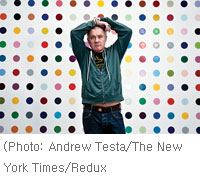 Spots and Sharks and Maggots and Money
Spots and Sharks and Maggots and Money
How Damien Hirst took over the worldDamien Hirst is the Elvis of the English art world, its ayatollah, deliverer, and big-thinking entrepreneurial potty-mouthed prophet and front man. Hirst synthesizes punk, Pop Art, Jeff Koons, Marcel Duchamp, Francis Bacon, and Catholicism. He’s the working-class hero who as a 23-year-old art student at the University of London’s Goldsmiths college organized “Freeze,” an exhibition of his artwork and that of fifteen school chums.
That show, and his own work featuring living flies and maggots, dead butterflies, and cut-up dead animals, de-islandized England, alerting the world that Britain was no longer a second-tier art nation. While Hirst did not act alone, it is almost impossible to imagine the Tate Modern or the “yBa” (young British artists) phenomenon of the nineties without his ambitions and aggression. Or his easy outrages: public drinking and drugging, saying things like “Women smell of kippers,” meeting a curator naked, or tucking a chicken bone into his foreskin at a bar.
Two decades in, the father of three sons, operator of six studios, boss of (he says) 160 employees, one of Britain’s wealthiest citizens, Hirst is back and blatant as ever. Next week he’ll open a retrospective of more than 300 of his multitudinous, assistant-made “spot paintings.” As Hirst has said, “I always … treat [art] as an all-or-nothing situation. There’s no way I’m going to settle for half.” Hence the survey will be mounted simultaneously worldwide at all eleven of Larry Gagosian’s galleries. For five weeks, the sun will never set on a Hirst spot.
 Spots and Sharks and Maggots and Money
Spots and Sharks and Maggots and Money